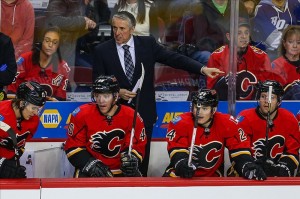As the season winds down, the Calgary Flames are hovering around the playoff picture. Their success has been well-documented, as has the perception that it’s a bit befuddling considering the expectations of the hockey world heading into the season.

Here’s a few quick facts about the Calgary Flames.
- They frequently get out-shot.
- They spend an awful lot of their even-strength time in their own zone.
- They don’t have much in the way of established NHL stars on their roster, though Johnny Gaudreau, Mark Giordano and Sean Monahan likely qualify by this point.
However, what the Calgary Flames do have is a very established team identity, and a coach that has developed systems around his players. And the group’s success with their system dates back beyond this season, way back to the January 18, 2014 line brawl in Vancouver. In the 106 games since that Donny-brook, the Flames have a 59-41-6 record – a 58.5 points percentage, worth about 96 points (and a likely playoff spot) over an 82-game schedule.
So how are they doing it?
Much like a blackjack player attempts to beat the the house in a casino through a system of card-counting, designed to maximize their tiny chances at success based on maximizing what they know and that they can control, the Calgary Flames have attempted to do something similar in terms of their on-ice systems.
DEFENSE
If you want to simplify things, here’s brass tacks: the Calgary Flames more or less pretend they’re on the penalty kill when they’re in their own zone. Players attempting carry-ins with the puck are typically corralled to the boards and the corners of the zone as often as they can be – the team has some trouble when the opposition attackers are fleet-footed – and sticks are used to knock loose passes and disrupt the setting up of an offensive zone by the other team.
When they fail to disrupt, the team falls into a penalty killing box, with the fifth man (usually the center) acting as a rover, pressuring the puck carrier and attempting to create turnovers and odd-man rushes the other way. (Paul Byron, Johnny Gaudreau and Lance Bouma are among the best on the club at creating these turnovers.)
OFFENSE
When the Flames do have the puck, they tend to attack through a rush, and typically try to complicate the defenders picking up the appropriate man to check by having many bodies enter the zone at the same time. Quiet often – particularly when T.J. Brodie and/or Mark Giordano are on the ice – a defender will take a pass and lead the rush, thereby forcing the two defenders to deal with four different attackers (and the trailing defenseman) and opening up shooting lanes. Passes are often executed at the blue-line or shortly after a zone-entry, again to confuse opposition schemes.
If that fails, they establish an offensive zone and more or less handle things like they’re running a power-play
An alternate attack tactic – typically attempted when they’ve been defending a lot and need a line change – is one puck-carrier taking the puck deep and then multiple trailing players coming into the zone at the same time, again, with the view towards complicating defensive pick-ups.
TRANSITIONS
Now, by this point you’re probably thinking one thing: it sure sounds like the defensemen are pretty key to their attack. And you are correct. That leads to another logical conclusion – they must be worried about odd-man rushes going back the other way.
And because of that, the primary defenders who jump into the rush are typically Brodie, Giordano and Dennis Wideman, players who are (a) decently fast and agile and (b) paired with defensively responsible partners who can bail them out if a rush fails and goes back the other way. The forwards are also tasked with rushing back, with a common tactic being stick-checking on the way back to either steal the puck or merely complicate the other team’s zone entry and create off-side situations.
TACTICS HAVE BEEN KEY
Let’s be honest here – the Calgary Flames are a team that’s figured out a way to be greater than the sum of its parts. Few saw this roster at the beginning of the regular season and said to themselves, “This is a team that will give other groups fits at times.” But they have. Repeatedly.
And they have done so with tactics that have maximized what they have to work with. They don’t have a lot of top-shelf NHL talent – although some of their young players are definitely progressing quickly – but they do have a few fast defensemen who are able to jump into the rush and complicate life for the opposition.
Is getting out-shot every game a sustainable strategy? Definitely not. But Bob Hartley’s coaching staff has devised a playing system that, for now, has allowed the Flames not to be punished for this tendency to the degree that the underlying statistics suggest they should be. It remains an open question, with several games remaining on the schedule, if Hartley’s playing scheme will result in a playoff berth for his club.